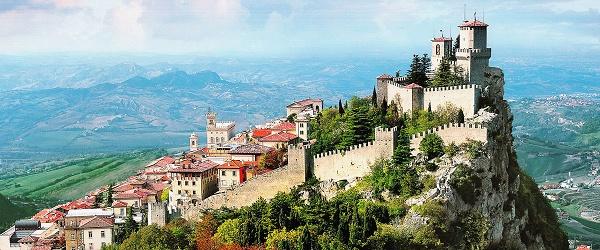San Marino
In 1974, I took a year off from my doctoral studies and teaching philosophy at the University of Southern California at the suggestion of the Chairman of the USC School of Philosophy, John Hospers.
John had been the 1972 presidential candidate of the Libertarian Party and was involved in the New Country Project. Financed by wealthy libertarians such as Mike Oliver from Nevada, this was an effort to locate some viable piece of real estate in the world that could be transformed into an actual sovereign nation founded on libertarian principles of minimal government.
Such a country was to have total free trade with no customs or tariffs on any imported goods; no corporate, income, or sales taxes; and a government restricted to a police force, a small professional military, and courts.
Government expenses were to be paid from contract fees – for the courts to recognize any sort of contractual relationship, the parties would pay a fee for the contract to be legally binding.
John Hospers and Mike Oliver sent me out into the world to locate where such a new country could be established. I spent a year going to some very weird places.
There was Minerva Reef in the South Pacific that was submerged at high tide. When Mike Oliver claimed sovereignty for it, as it had never been claimed by any other country before, the King of Tonga decided it was his, chartered a boat, and all 380 pounds of him got off the boat and planted a Tonga flag on Minerva at low tide, which was washed away at high tide.
Then there was the cannibal tribe I almost made a deal with in the New Hebrides (now called Vanuatu).
There was a privately owned island in the Trobriand Islands off Papua New Guinea that we almost bought, until the Australian Navy said they would land their Marines if we declared sovereignty.
We came close to buying the island of Abaco in the Bahamas, only to find the Bahamian Prime Minister, Linus Pindling, was a complete crook.
There were lots of other similar places and situations – don’t even get me started on Africa – but the bottom line was always the same. The minute it dawned on folks in power we wanted to purchase outright for-real sovereignty, any deal was off. They were willing to sell anything, absolutely anything – except real, true, sovereignty.
So the New Country Project turned out to be a ridiculous, and ridiculously funny, pipe dream. But I sure did have a lot of fun adventuring for a year.
Experience the Insider community that takes your international lifestyle to the next level. Download your FREE guide
"18 Steps to Implementing Your Plan B" instantly!
The memories of that year were brought back to me recently with visits to two tiny micro-states in Europe that have managed to keep their sovereignty and not be swallowed by their giant neighbors: Liechtenstein and Andorra.
There are four of these European micro-states in all, the other two being San Marino and Monaco. (There is a fifth, the world’s smallest country, Vatican City, ruled of course by the Pope – but that’s a special case.)
Survey the history of Europe, and you can easily get overwhelmed by the shifting kaleidoscope of fiefdoms popping in and out of existence, expanding into kingdoms and empires, then breaking into pieces, with most of the pieces vanishing and others starting the cycle anew.
Most of the modern nations of Europe emerged out of this kaleidoscope recently, being assembled in the 19th or 20th centuries. How in the world, then, has a tiny dot on the map like Liechtenstein managed to stay sovereign with its borders unchanged since 1434? Or San Marino since 1463, Monaco since 1297, and Andorra since 1278?
Liechtenstein is a 160-square-kilometer wedge (smaller than Washington, D.C.) between Switzerland and Austria:
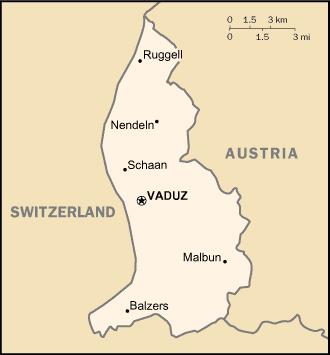
(It’s one of the only two “double-landlocked” countries in the world: surrounded by countries that are themselves landlocked. The other is Uzbekistan.)
In 1434, the Upper Rhine was established as the border between the Holy Roman Empire and the cantons of Switzerland that had gained their freedom from it. On the Empire’s side, there were the medieval counties of Vaduz and Schellenberg directly ruled by the Emperor with no dukes or counts in between.
It was an attractive yet isolated and ignored spot that was allowed to fend for itself. This picture was taken from the Liechtenstein village of Triesenberg. That’s Switzerland on the other side of the Rhine:
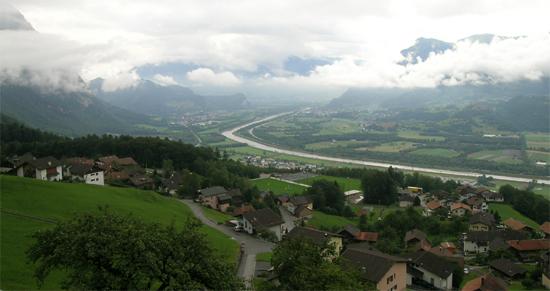
The rulers of the Holy Roman Empire were the Hapsburgs, whose financial advisors were from a wealthy family that took its name from a castle in southern Austria they had owned since 1140: Liechtenstein (“Bright Stone”).
In 1699, Prince Adam Andreas of Liechtenstein bought Schellenberg from the Hapsburg Emperor, Charles VI, and Vaduz in 1712. In 1718, the Emperor decreed that the patch of mountain villages would henceforth be known as the Principality of Liechtenstein. It has been ruled by the Liechtenstein family ever since.
When Napoleon dissolved the Holy Roman Empire in 1806, the family paid off his foreign minister Talleyrand (1754-1838) to keep Liechtenstein’s independence, and again in 1815 when Talleyrand negotiated the dissolution of Napoleon’s empire at the Congress of Vienna.
The Hapsburgs recreated the Holy Roman Empire as the Austro-Hungarian Empire and allowed Liechtenstein to remain free on the condition it declare permanent neutrality between all nations. It did so in 1868 and disbanded its army of 80 soldiers.
Maintaining its neutrality and independence through both World Wars, Liechtenstein prospered due to the financial savvy of Prince Franz Josef II, who ruled from 1938 to 1989, and his son, the current ruler Prince Hans-Adam II.
As other European countries moved to socialism, Franz Josef did the opposite, establishing a free enterprise economy with low business taxes (maximum rate is 18%), easy incorporation rules (there are now over 75,000 companies with “letter box” offices in the country – more than two for every Liechtensteiner), and strict banking secrecy (tighter than Switzerland).
Today, the Prince has a personal wealth of four billion dollars, while the 37,000 Liechtensteiners enjoy one of the world’s highest standards of living (albeit very unpretentiously with no flashy signs of wealth) in a safe, peaceful, and crime-free country.
The Prince’s castle (now being remodeled) sits on a cliff above Vaduz, the capital:
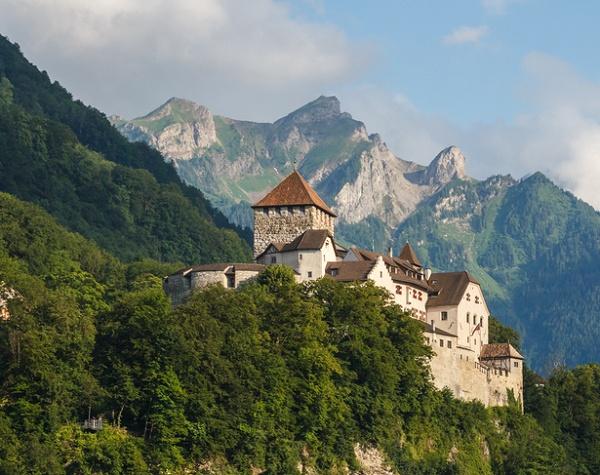
And everything is so peaceful and benign that my boys, Jackson and Brandon, who joined us in Europe, thought the place boring.
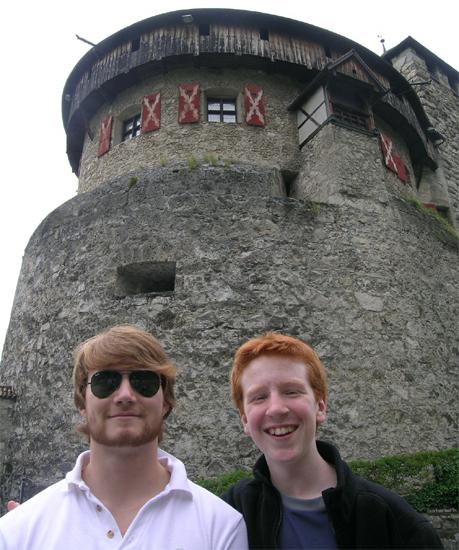
I had taken Brandon to Monaco and San Marino some years ago. Monaco, of course, is one of the flashiest places on earth, while San Marino is still a medieval mountain fortress.
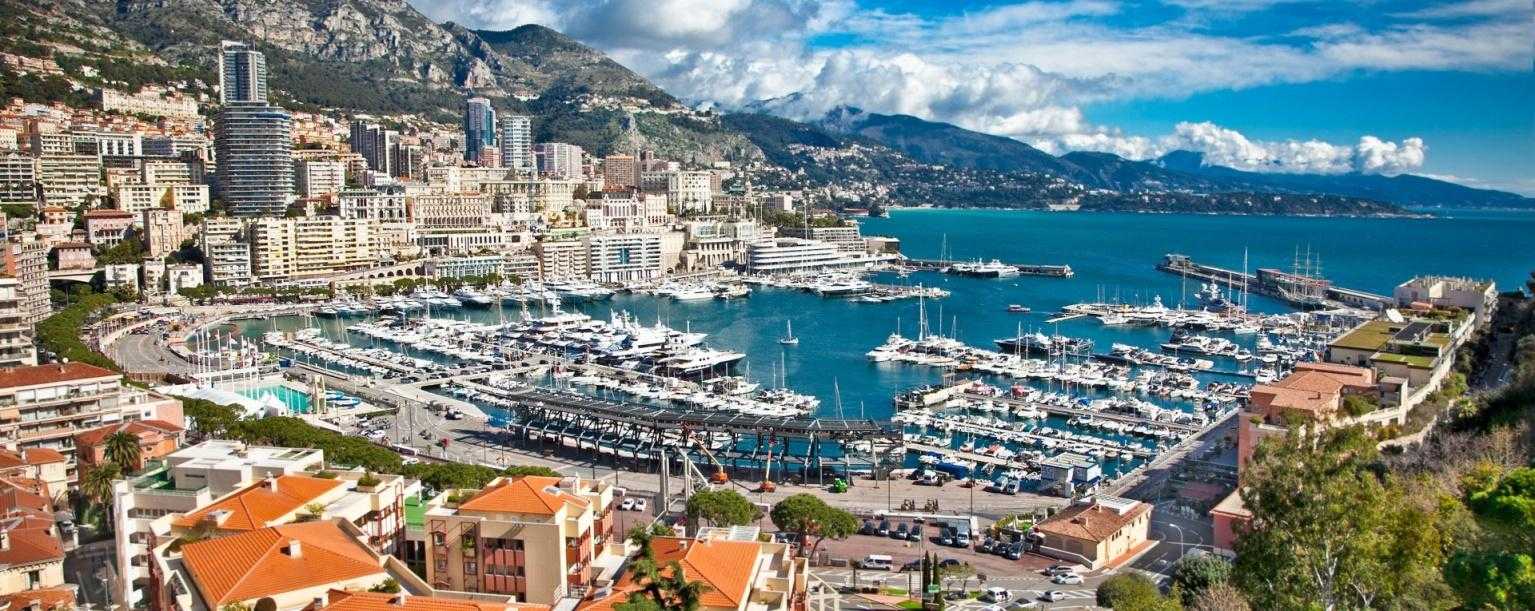
Monaco was originally a Greek colony founded in the 6th century BC called Monoikos (“single house”), where the colonists built a temple to their god Heracles (Hercules).
Holy Roman Emperor Henry VI gave the nearby city-state of Genoa a land grant to Monaco in 1191. A little over 100 years later in 1297, the head of a Genoese aristocratic family that had settled there, Francois Grimaldi, seized the fortress at the Rock of Monaco and took the place over.
The Grimaldi princes have ruled it ever since. When Napoleon threatened, they followed Liechtenstein’s lead and paid off Talleyrand, and again at the Congress of Vienna. France finally and formally recognized Monaco’s independence in the Franco-Monegasque Treaty of 1861.
The most famous of the Grimaldis is Prince Rainier because of his marriage to Grace Kelly. When Rainier died in 2005, his and Princess Grace’s son, Prince Albert II, succeeded him.
Astride the French Riviera on the Mediterranean, Monaco is the world’s smallest state (aside from the Vatican) at less than two square kilometers (that’s less than one square mile, about 600 acres):
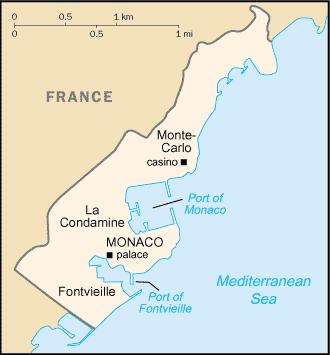
Tourism is the main business, that and providing a tax haven with no income tax for its 32,000 residents. Thus, Monaco is populated by millionaire “tax refugees” from all over socialist-confiscatory Europe. It’s an expensive and glamorous place to live – and well worth it, unless you’re an American.
For our government is the only one in the world (along with Eritrea) that taxes its citizens on worldwide income, even if they are residents of another country, like Monaco.
San Marino isn’t quite as ancient as 2,600-year-old Monaco, being founded by Marinus the Dalmatian (later St. Marino) in 301 AD on Mount Titano as a refuge for Christians escaping from Roman Emperor Diocletian.
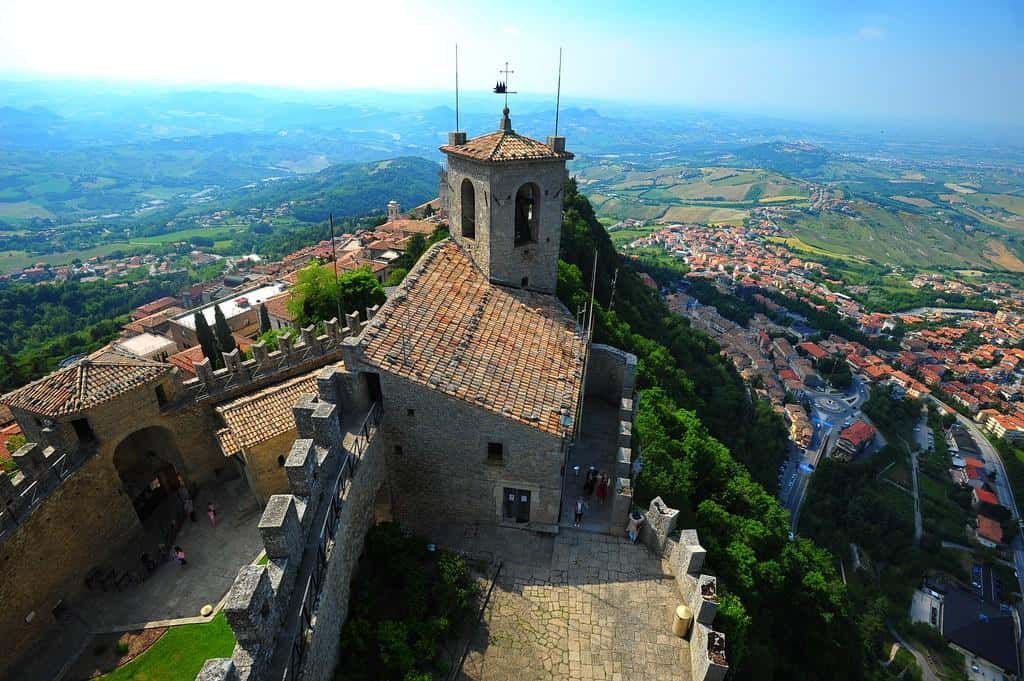
The owner of the mountain, a lady from the nearby city of Rimini on Italy’s Adriatic Coast named Felicissima, gave the land in sympathy to Marinus’ Christian community.
It stayed a free commune for centuries, governed by an assembly known as the Aregno composed of the heads of Marinan families like the original Roman Senate. In 1243, the Aregno established two positions of Capitani Reggenti (Captains Regent) to be joint heads of state. This remains the government structure to this day.
In 1291, the Vatican affirmed the ancient independence of San Marino, and in 1463, Pope Pius II awarded it the towns and castles of six adjoining hills to compose the San Marino of today, all 61.2 square kilometers of it:
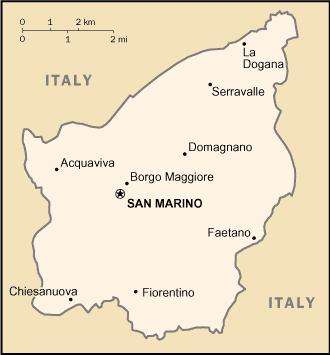
The San Marinese fought off the army of Cesare Borgia in 1503 and an attempt to absorb it into the Papal States in 1739, which got Napoleon to recognize it in 1797, and Talleyrand to recognize it at the Congress of Vienna in 1815 – without having to pay him off.
While Garibaldi was unifying Italy in the mid-19th century, San Marino provided a refuge for his supporters. When he succeeded in creating the unified Kingdom of Italy, in 1862, he granted San Marino’s wish to remain an independent republic.
Thus, San Marino is the last surviving Italian city-state – and the world’s oldest republic. Its 29,000 citizens make a fortune off tourism and providing a banking and tax haven for those seeking refuge from predatory governments.
You can see the Adriatic Sea from San Marino, and Monaco is on the Med. Andorra, like Liechtenstein tucked away in the Alps, is hidden in the Pyrenees Mountains which form the border between France and Spain.
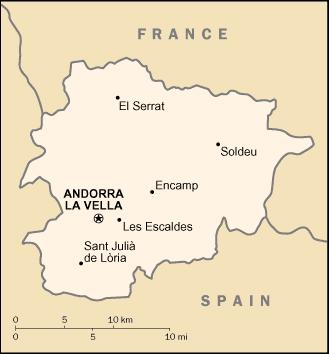
Andorra owes its existence to Charlemagne (742-814), who granted, in 788, the local people controlling the mountain passes sovereignty in exchange for their fighting Moslem Moors trying to invade Christian France from Islamic Spain.
When the Moslem tide receded in the 800s, the Catholic Diocese of Urgell just south of Andorra in Spanish Catalonia assumed its protection. 400 years later, the French Count of Foix just north of Andorra claimed the right of protection.
To settle the dispute, in 1278 the Count of Foix and the Bishop of La Seu d’Urgell signed a paréage, a feudal institution of agreement between two equal rulers. The paréage granted Andorra perpetual sovereignty in return for an annual tribute (a questia) to the Count and the Bishop of four hams, 40 loaves of bread, and two casks of wine.
The payment has been made annually for 728 years.
Andorra was ignored by Napoleon, forgotten by Talleyrand, all of Europe (save for the Count and the Bishop), and smugglers between Spain and France. Its smuggling heritage comes in handy today.
While Andorra is a banking and tax haven, it doesn’t have the financial sophistication and expertise of Liechtenstein. Instead, its 70,000 Andorrans depend on a flood of shoppers from Spain and France buying duty and tax-free goods.
Since there are no airports, you have to drive to Andorra over high mountain passes. The traffic jams on these winding roads – one from France, one from Spain – are miles long. The main town and capital of Andorra la Vella is shoehorned into a valley with its narrow streets lined with shops and stores and malls selling booze, watches, cameras, electronics, clothes, etc. Nine million visitors a year drive from all over Europe to this tiny remote mountain valley just to buy stuff without paying taxes or duties:
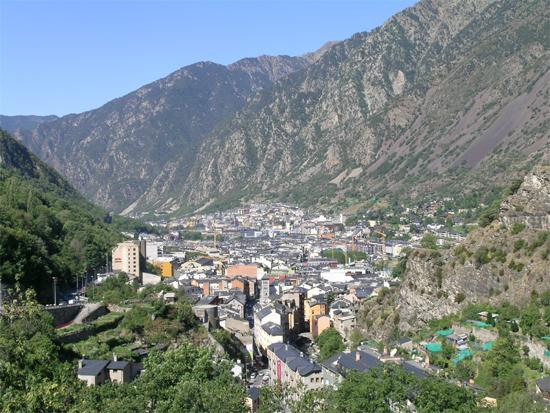
Gasoline is tax-free, too: €1.05 euros per liter, compared to €1.45 in France ($3.90 a gallon vs. $5.50 – yes, gas is way over $5 a gallon in most all of Europe).
You see the pattern. All of these mini-states are tax havens. They have minimal government interference in their economies, yet provide efficient administration and a reliable rule of law – with effective, yet very discreet police protection ensuring virtually crime-free public safety.
The result is a happy, free, and prosperous country. You’d think other countries would grasp the pattern and replicate it. It’s a puzzle why they don’t.
Perhaps part of the answer is the greater puzzle of how these mini-states have been allowed to exist and flourish by their massive – and envious – neighbors.
Envy is the basis of all forms of socialism and high tax rates. It’s the fundamental basis of the European welfare state. It must be that the big welfare states see these tiny tax havens as so small they are no threat, yet serve as useful safety valves for the rich to escape from the envious.
Without the safety valves, the rich might stay and try to force changes in the welfare states.
Even so, another part of the reason must be a basic civilized decency in Europe to leave alone these little countries that have had the luck of history to still exist. It would be hard to even imagine, say, Italy sending its army into San Marino and taking it over, the way Indira Gandhi ordered the Indian Army to invade the tiny independent kingdom of Sikkim (in the Himalayas between Nepal and Bhutan) in 1975.
Sikkim today no longer exists as a sovereign nation, but as a state of India.
Traveling around the world, I have always been fascinated by how a country came into being and gained its sovereignty. There’s no set formula. A lot of it is sheer chance, the vagaries of history. A lot of it depends on the intelligence and will of its people. The will to be free and independent.
America was created by that will. It is such a tragedy that it has lost so much of it, that America is not a tax haven and is ruled by a government of leviathan proportions.
Yet it would be foolish to think a nation of enormous size (the third-largest on earth after Russia and Canada, with over 3.2 million square miles) and population (again the third-largest after China and India, with 320 million) should be governed like statelets of a few square miles or less with some tens of thousands of people.
Well, maybe not so foolish. Not so foolish at all. We need to look at these tiny states as establishing a clear pattern of freedom and prosperity. They are beacons of sovereignty shining light on how any nation, no matter how big or small, can flourish.
They make the requirements for such flourishing obvious: Free trade, low taxes, an honest and dependable judicial system, no tolerance for crime and violence, an educated people with the will to be free.
Americans need to learn the lesson these beacons of sovereignty, like Liechtenstein and Andorra and San Marino and Monaco, are teaching us. Then America can be again the beacon of sovereignty it once was.
Jack Wheeler is the founder of Wheeler Expeditions.
This article was published in the Escape Artist Weekly Newsletter on November 27, 2017. If you would like to subscribe to the newsletter, please click here.
©2019 Jack Wheeler – republished with permission
Like Our Articles?
Then make sure to check out our Bookstore... we have titles packed full of premium offshore intel. Instant Download - Print off for your private library before the government demands we take these down!

